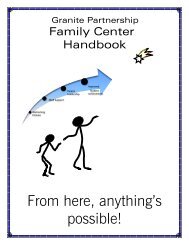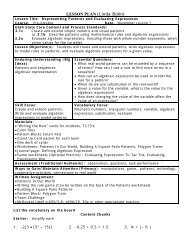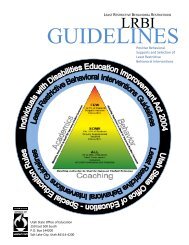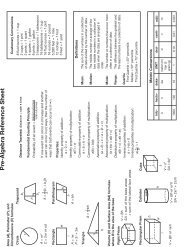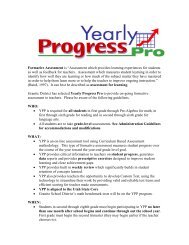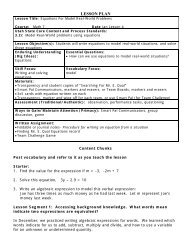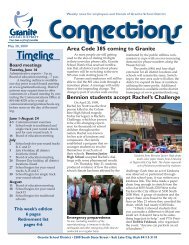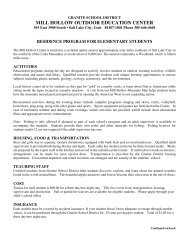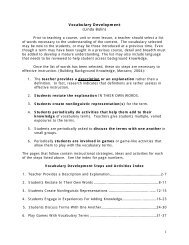Utah Special Education Paraeducator Handbook - Granite School ...
Utah Special Education Paraeducator Handbook - Granite School ...
Utah Special Education Paraeducator Handbook - Granite School ...
Create successful ePaper yourself
Turn your PDF publications into a flip-book with our unique Google optimized e-Paper software.
Consequences<br />
Remember from the ABCs of behavior that consequences follow a behavior. In order to be proactive you<br />
and the teacher should have planned for these in advance. Consequences should be logical and<br />
connected to the behavior. It is logical because it "fits" the nature of the behavior. For example, if a<br />
student completes his work early, he is able to do something he enjoys such as reading a book. If a<br />
student fails to complete an in-class assignment, she will have to finish it during free time. These are<br />
examples of reasonable consequences that match the behavior.<br />
For more information on proactive strategies see:<br />
http://www.una.edu/faculty/onlineacademy/State/Adobe%20Reader/DO%20NOT%20OPEN%20progra<br />
m%20files/Management/During%20-%20Encouragement%20.pdf.<br />
B. Support the supervisor’s behavior management plan<br />
It is the responsibility of your supervising teacher to create and implement the classroom management<br />
plan. As a member of the instructional team, it is your responsibility to support that plan through words<br />
and actions. This is important. Students learn and progress when all team members are on the same<br />
page.<br />
<strong>Paraeducator</strong>s show support when they prompt or remind students to follow classroom expectations or<br />
rules, enforce consequences, and encourage students to meet expectations. Examples of supporting the<br />
behavior management plan include:<br />
<br />
<br />
<br />
<br />
<br />
reminding a student to stop talking and focus on the task at hand,<br />
praising students who are listening and paying attention,<br />
redirecting a student who is distracted,<br />
at the teacher’s request, directing a student to another seat as a consequence for continuing to<br />
talk to classmate, and<br />
praising a student for making a good choice.<br />
Section 2: Supporting Competencies<br />
C. Demonstrate knowledge of learner characteristics and factors that influence behavior<br />
A student's disability affects his or her learning needs. It is important for you to understand how a<br />
child’s disability affects learning. If a student is classified with one disability, she may also have<br />
characteristics of other disabilities. For example, a student may be classified as having a specific<br />
learning disability. Due to years of frustration in school, the student may have learned some acting out<br />
behaviors that interfere with his or his ability to learn. A good Individualized <strong>Education</strong> Plan (IEP)<br />
addresses all behaviors of concern for that particular student.<br />
The more you understand and relate to your student’s needs, strengths, and learning styles, the more<br />
you can assist and support them. Students feel comfortable with someone who understands their<br />
<strong>Utah</strong> <strong>Paraeducator</strong> <strong>Handbook</strong> Page 38




